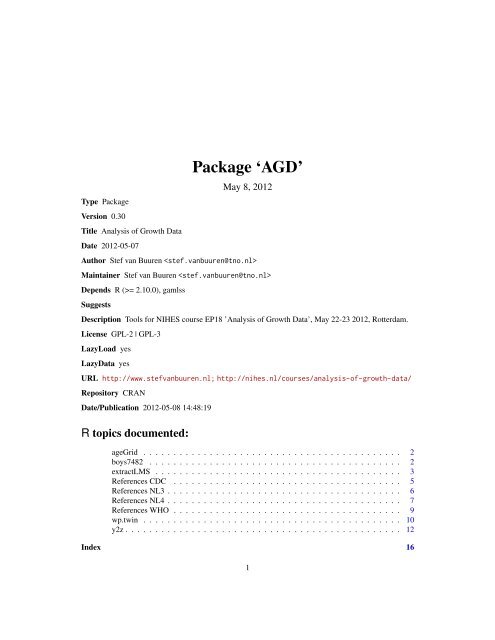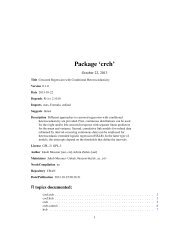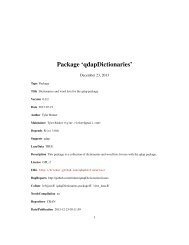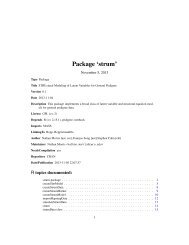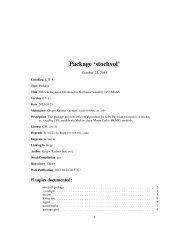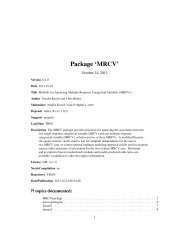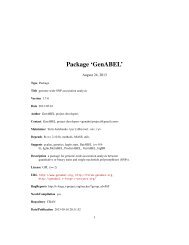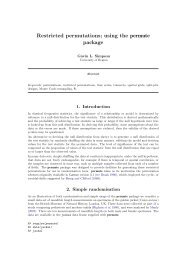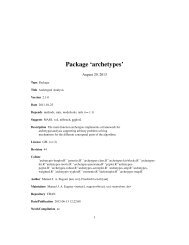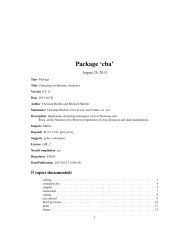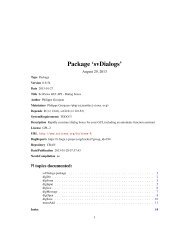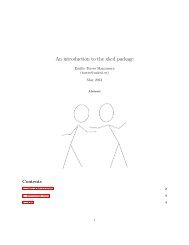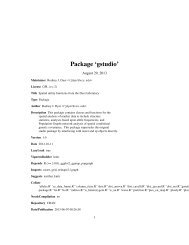Package 'AGD'
Package 'AGD'
Package 'AGD'
You also want an ePaper? Increase the reach of your titles
YUMPU automatically turns print PDFs into web optimized ePapers that Google loves.
Type <strong>Package</strong><br />
Version 0.30<br />
Title Analysis of Growth Data<br />
Date 2012-05-07<br />
<strong>Package</strong> ‘AGD’<br />
May 8, 2012<br />
Author Stef van Buuren <br />
Maintainer Stef van Buuren <br />
Depends R (>= 2.10.0), gamlss<br />
Suggests<br />
Description Tools for NIHES course EP18 ’Analysis of Growth Data’, May 22-23 2012, Rotterdam.<br />
License GPL-2 | GPL-3<br />
LazyLoad yes<br />
LazyData yes<br />
URL http://www.stefvanbuuren.nl; http://nihes.nl/courses/analysis-of-growth-data/<br />
Repository CRAN<br />
Date/Publication 2012-05-08 14:48:19<br />
R topics documented:<br />
ageGrid . . . . . . . . . . . . . . . . . . . . . . . . . . . . . . . . . . . . . . . . . . . 2<br />
boys7482 . . . . . . . . . . . . . . . . . . . . . . . . . . . . . . . . . . . . . . . . . . 2<br />
extractLMS . . . . . . . . . . . . . . . . . . . . . . . . . . . . . . . . . . . . . . . . . 3<br />
References CDC . . . . . . . . . . . . . . . . . . . . . . . . . . . . . . . . . . . . . . 5<br />
References NL3 . . . . . . . . . . . . . . . . . . . . . . . . . . . . . . . . . . . . . . . 6<br />
References NL4 . . . . . . . . . . . . . . . . . . . . . . . . . . . . . . . . . . . . . . . 7<br />
References WHO . . . . . . . . . . . . . . . . . . . . . . . . . . . . . . . . . . . . . . 9<br />
wp.twin . . . . . . . . . . . . . . . . . . . . . . . . . . . . . . . . . . . . . . . . . . . 10<br />
y2z . . . . . . . . . . . . . . . . . . . . . . . . . . . . . . . . . . . . . . . . . . . . . . 12<br />
Index 16<br />
1
2 boys7482<br />
ageGrid Creates an age grid according to a specified format.<br />
Description<br />
Usage<br />
Creates an age grid according to a specified format.<br />
Arguments<br />
Value<br />
ageGrid(grid = "compact")<br />
grid A character string specifying one of the following: "compact", "classic",<br />
"extensive", "0-104w", "0-24m", "0-21y", "0-21yd" or "0-21yc". The default<br />
is "compact", which produces an age grid between 0 and 21 years with 95<br />
points.<br />
A list with five components: format, year, month, week and day containing the age grid in different<br />
units.<br />
Author(s)<br />
Stef van Buuren, 2010<br />
Examples<br />
age
extractLMS 3<br />
Format<br />
Details<br />
A data frame with 7482 rows on the following 9 variables:<br />
age Decimal age (0-21 years)<br />
hgt Height (cm)<br />
wgt Weight (kg)<br />
bmi Body mass index<br />
hc Head circumference (cm)<br />
gen Genital Tanner stage (G1-G5)<br />
phb Pubic hair (Tanner P1-P6)<br />
tv Testicular volume (ml)<br />
reg Region (north, east, west, south, city)<br />
The complete sample of cross-sectional data from boys 0-21 years used to construct the Dutch<br />
growth references 1997. Variables gen and phb are ordered factors. reg is a factor. Note: A 10%<br />
sample from this data is available in data set boys in the mice package.<br />
Author(s)<br />
Source<br />
Stef van Buuren, 2012<br />
Fredriks, A.M„ van Buuren, S., Burgmeijer, R.J., Meulmeester JF, Beuker, R.J., Brugman, E.,<br />
Roede, M.J., Verloove-Vanhorick, S.P., Wit, J.M. (2000) Continuing positive secular growth change<br />
in The Netherlands 1955-1997. Pediatric Research, 47, 316-323. http://www.stefvanbuuren.<br />
nl/publications/Continuingsecular-PedRes2000.pdf<br />
Fredriks, A.M., van Buuren, S., Wit, J.M., Verloove-Vanhorick, S.P. (2000). Body index measurements<br />
in 1996-7 compared with 1980. Archives of Disease in Childhood, 82, 107-112. http:<br />
//www.stefvanbuuren.nl/publications/Bodyindex-ADC2000.pdf<br />
extractLMS Extracts LMS values from a gamlss object.<br />
Description<br />
Usage<br />
Extract LMS values from a gamlss object for solutions that transform the age axis according to the<br />
M-curve.<br />
extractLMS(fit, data, sex = "M", grid = "classic",<br />
decimals = c(4,4,4), flatAge=NULL)
4 extractLMS<br />
Arguments<br />
Details<br />
Value<br />
fit A gamlss object containing the final fit on transformed age, t.age.<br />
data A data frame containing the original data, with both age and t.age<br />
sex A character vector indicating whether the fit applied to males sex="M" or females<br />
sex="F". The default is sex="M".<br />
grid A character vector indicating the desired age grid. See ageGrid() for possible<br />
options. The default is a grid="classic", a grid of 59 age points.<br />
decimals A numerical vector of length 3 indicating the number of significant digits for<br />
rounding of the L, M and S curves, respectively.<br />
flatAge A scalar indicating the age beyond which the L, M and S values should be constant.<br />
The default (NULL) is not to flatten the curves.<br />
It is crucial that t.age in data correspond to exactly the same age transformation as used to fit the<br />
gamlss object. Age grid values beyond the range of data$age produce NA in the L, M and S values.<br />
Parameter flatAge should be one of the values of the age grid.<br />
A data frame with rows corresponding to time points, and with the following columns: sex,x,L,M,S.<br />
Author(s)<br />
Stef van Buuren, 2010<br />
Examples<br />
#<br />
library(AGD)<br />
boys
References CDC 5<br />
control=gamlss.control(n.cyc=3))<br />
# extract the LMS reference table in the ’classic’ age grid<br />
nl4.hgt.boys
6 References NL3<br />
Details<br />
Source<br />
The models were fitted by the LMS model. Parameters are stored as type LMS. Tabulated values are<br />
point ages.<br />
The naming conventions are as follows:<br />
cdc.hgt Combined length/height (cm) for Age, 0-20 years. Measures = 2 years apply to height, or stature (standing).<br />
cdc.wgt Weight (kg) for Age, 0-20 years.<br />
cdc.bmi Body Mass Index (kg/m2) for Age, 2-20 years)<br />
Kuczmarski RJ, Ogden CL, Guo SS, Grummer-Strawn LM, Flegal KM, Mei Z, Wei R, Curtin LR,<br />
Roche AF, Johnson CL. 2000 CDC growth charts for the United States: methods and development.<br />
Vital Health Stat, 2002, 11, 246, 1-190.<br />
See Also<br />
nl4.wgt, nl4.hgt, nl4.bmi, who.wgt<br />
References NL3 Reference tables from Third Dutch Growth Study 1980<br />
Description<br />
Usage<br />
Format<br />
Reference table from the Third Dutch Growth Study 1980<br />
data(nl3.bmi)<br />
A data frame with seven variables:<br />
pop Study Population<br />
sub Subpopulation, e.g. ethnicity or age group (for nl4.wfh)<br />
sex Sex (M,F)<br />
x Decimal age (0-21 years) or Height (for nl4.wfh)<br />
L Lambda (skewness) curve<br />
M Median curve<br />
S Coefficient of Variation curve
References NL4 7<br />
Details<br />
Source<br />
The model was fitted by the LMS model. Parameters are stored as type LMS. Tabulated values are<br />
point ages.<br />
Height follows a normal distribution, with all lambda parameters set equal to 1. The standard<br />
deviation (in cm) is obtained as S*M.<br />
The naming conventions are as follows:<br />
nl4.hgt Length/Height (cm) for Age<br />
nl4.wgt Weight (kg) for Age<br />
nl4.wfh Weight (kg) for Height (cm)<br />
nl4.bmi Head circumference (cm) for Age<br />
nl4.lgl Leg Length (cm) for Age<br />
nl4.hip Hip circumference (cm) for Age<br />
nl4.wst Waist circumference (cm) for Age<br />
nl4.whr Waist/Hip ratio for Age<br />
nl4.sit Sitting Height for Age<br />
nl4.shh Sitting Height/Height ratio for Age<br />
Fredriks, A.M„ van Buuren, S., Burgmeijer, R.J., Meulmeester JF, Beuker, R.J., Brugman, E.,<br />
Roede, M.J., Verloove-Vanhorick, S.P., Wit, J.M. (2000) Continuing positive secular growth change<br />
in The Netherlands 1955-1997. Pediatric Research, 47, 316-323. http://www.stefvanbuuren.<br />
nl/publications/Continuingsecular-PedRes2000.pdf<br />
Fredriks, A.M., van Buuren, S., Wit, J.M., Verloove-Vanhorick, S.P. (2000). Body index measurements<br />
in 1996-7 compared with 1980. Archives of Disease in Childhood, 82, 107-112. http:<br />
//www.stefvanbuuren.nl/publications/Bodyindex-ADC2000.pdf<br />
See Also<br />
cdc.wgt, who.wgt<br />
References NL4 Reference tables from Fourth Dutch Growth Study 1997<br />
Description<br />
Reference table from the Fourth Dutch Growth Study 1997
8 References NL4<br />
Usage<br />
Format<br />
Details<br />
data(nl4.hgt)<br />
data(nl4.wgt)<br />
data(nl4.wfh)<br />
data(nl4.bmi)<br />
data(nl4.hdc)<br />
data(nl4.lgl)<br />
data(nl4.hip)<br />
data(nl4.wst)<br />
data(nl4.whr)<br />
data(nl4.sit)<br />
data(nl4.shh)<br />
A data frame with seven variables:<br />
pop Study Population<br />
sub Subpopulation, e.g. ethnicity or age group (for nl4.wfh)<br />
sex Sex (M,F)<br />
x Decimal age (0-21 years) or Height (for nl4.wfh)<br />
L Lambda (skewness) curve<br />
M Median curve<br />
S Coefficient of Variation curve<br />
The model was fitted by the LMS model. Parameters are stored as type LMS. Tabulated values are<br />
point ages.<br />
Height follows a normal distribution, with all lambda parameters set equal to 1. The standard<br />
deviation (in cm) is obtained as S*M.<br />
The naming conventions are as follows:<br />
nl4.hgt Length/Height (cm) for Age<br />
nl4.wgt Weight (kg) for Age<br />
nl4.wfh Weight (kg) for Height (cm)<br />
nl4.bmi Head circumference (cm) for Age<br />
nl4.lgl Leg Length (cm) for Age<br />
nl4.hip Hip circumference (cm) for Age<br />
nl4.wst Waist circumference (cm) for Age<br />
nl4.whr Waist/Hip ratio for Age<br />
nl4.sit Sitting Height for Age<br />
nl4.shh Sitting Height/Height ratio for Age
References WHO 9<br />
Source<br />
Fredriks, A.M„ van Buuren, S., Burgmeijer, R.J., Meulmeester JF, Beuker, R.J., Brugman, E.,<br />
Roede, M.J., Verloove-Vanhorick, S.P., Wit, J.M. (2000) Continuing positive secular growth change<br />
in The Netherlands 1955-1997. Pediatric Research, 47, 316-323. http://www.stefvanbuuren.<br />
nl/publications/Continuingsecular-PedRes2000.pdf<br />
Fredriks, A.M., van Buuren, S., Wit, J.M., Verloove-Vanhorick, S.P. (2000). Body index measurements<br />
in 1996-7 compared with 1980. Archives of Disease in Childhood, 82, 107-112. http:<br />
//www.stefvanbuuren.nl/publications/Bodyindex-ADC2000.pdf<br />
See Also<br />
cdc.wgt, who.wgt<br />
References WHO Reference tables from WHO 2006<br />
Description<br />
Usage<br />
Format<br />
Details<br />
Reference tables from WHO 2006<br />
data(who.wgt)<br />
A data frame with seven variables:<br />
pop Study Population<br />
sub Subpopulation<br />
sex Sex (M,F)<br />
x Decimal age (0-5 years)<br />
L Lambda (skewness) curve<br />
M Median curve<br />
S Coefficient of Variation curve<br />
The data were fitted by the LMS model. Parameters are stored as type LMS. Tabulated values are<br />
point ages. The ages cover 0-5 years.<br />
The naming conventions are as follows:<br />
who.wgt Weight (kg) for Age
10 wp.twin<br />
Source<br />
WHO Multicentre Growth Reference Study Group. WHO Child Growth Standards based on length/height,<br />
weight and age. Acta Paediatr, Suppl. 2006, 450, 76-85.<br />
See Also<br />
nl4.wgt, cdc.wgt<br />
wp.twin Superposes two worm plots<br />
Description<br />
Usage<br />
Superposes two worm plots from GAMLSS fitted objects. This is a diagnostic tool for comparing<br />
two solutions.<br />
wp.twin(obj1, obj2 = NULL, xvar = NULL, xvar.column = 2, n.inter = 16,<br />
show.given = FALSE, ylim.worm = 0.5, line = FALSE,<br />
cex = 1, col1 = "black", col2 = "orange", warnings = FALSE, ...)<br />
Arguments<br />
obj1 a GAMLSS fitted object<br />
obj2 an optional second GAMLSS fitted object<br />
xvar the explanatory variable against which the worm plots will be plotted<br />
xvar.column the number referring to the column of obj1$mu.x and obj2$mu.x. If xvar=NULL<br />
then the explanatory variable is set to xvar=obj1$mu.x[,xvar.column] respectively<br />
xvar=obj2$mu.x[,xvar.column]. The default is xvar.column=2,<br />
which selects the variable following the intercept (which is typically age in most<br />
applications).<br />
n.inter the number of intervals in which the explanatory variable xvar will be cut. The<br />
default is 16.<br />
show.given whether to show the x-variable intervals in the top of the graph, default is<br />
show.given=FALSE<br />
ylim.worm for multiple plots, this values is the y-variable limit, default value is ylim.worm=0.5<br />
line whether to plot the polynomial line in the worm plot, default value is line=FALSE<br />
cex the cex plotting parameter with default cex=1<br />
col1 the color for the points of obj1. The default col="black"<br />
col2 the color for the points of obj2. The default col="orange"<br />
warnings a logical indicating whether warnings should be produced. The default warnings=FALSE<br />
... for extra arguments, overlap, xlim.worm or pch
wp.twin 11<br />
Details<br />
Value<br />
This function is a customized version of the wp() function found in the gamlss package. Function<br />
wp.twin() allows overplotting of two worm plots, each in its own color. The points of obj1 are<br />
plotted first, the points of obj2 are superposed. This twin worm plot provide a visual assessment of<br />
the differences between the solutions. Extra arguments can be specified (e.g. xvar) that are passed<br />
down to the wp() function of gamlss if specified. The worm plot is a detrended normal QQ-plot<br />
that highlight departures from normality.<br />
Argument xvar takes priority over xvar.column. The xvar variable is cut into n.iter intervals<br />
with an equal number observations and detrended normal QQ (i.e. worm) plots for each interval are<br />
plotted. This is a way of highlighting failures of the model within different ranges of the explanatory<br />
variable.<br />
If line=TRUE and n.inter>1, the fitted coefficients from fitting cubic polynomials to the residuals<br />
(within each x-variable interval) can be obtain by e.g. coeffs
12 y2z<br />
y2z Conversion between measurements y and z-scores<br />
Description<br />
Usage<br />
Converts measurements into age- and sex-conditional standard deviation score (SDS) using an external<br />
reference.<br />
Arguments<br />
y2z(y=c(75, 80, 85), x = 1, sex = "M", sub = "N",<br />
ref = nl4.hgt, dist = "LMS", dec = 3,<br />
sex.fallback = "M", sub.fallback = "N")<br />
z2y(z=c(-2, 0, 2), x=1, sex = "M", sub = "N",<br />
ref = nl4.hgt, dist = "LMS", dec = 3,<br />
sex.fallback = "M", sub.fallback = "N")<br />
y A numerical vector containing the outcome measurements. The length length(y)<br />
determines the size of the output vector.<br />
z A numerical vector containing standard deviation scores that are to be converted.<br />
The length length(z) determines the size of the output vector.<br />
x A vector containing the values of the numerical covariate (typically decimal<br />
age or height) at which conversion is desired. Values are replicated to match<br />
length(y).<br />
sex A character vector indicating whether the male ("M") of female ("F")reference<br />
should be used. Values are replicated to match length(y).<br />
sub A character vector indicating the level of the sub field of the reference standard<br />
defined in ref<br />
ref A data frame containing a factor sex, a numerical variable age containing the<br />
tabulated decimal point ages, and two or more numerical variables with reference<br />
values. See details.<br />
dist A string identifying the type of distribution. Values values are: "NO", "BCCG",<br />
"LMS", "BCPE" and "BCT". The default is "LMS".<br />
dec A scalar value indicating the number of decimals used to round the value.<br />
sex.fallback The level of the sex field used when no match is found. The default is "M" for<br />
males. Specify sex.fallback="NA" if unmatched entries should receive a NA<br />
value.<br />
sub.fallback The level of the sub field used when no match is found. The default is "N" for<br />
normal. Specify sub.fallback="NA" if unmatched entries should receive a NA<br />
value.
y2z 13<br />
Details<br />
Value<br />
Functions z2y() and y2z() are the inverse of each other.<br />
The argument dist determines the statistical distribution. The possibilities are as follows:<br />
"NO" ref should contain columns mean and sd, containing the mean and the standard deviation in<br />
the external reference population.<br />
"LMS" ref should contain columns L, S and M containing the LMS parameters.<br />
"BCCG" ref should contain columns mu, sigma and nu containing the Box-Cox Cole-Green parameters.<br />
"BCPE" ref should contain columns mu, sigma, nu and tau containing the Box-Cox Power Exponential<br />
parameters.<br />
"BCT" ref should contain columns mu, sigma, nu and tau containing the Box-Cox T distribution<br />
parameters.<br />
For y2z(): A vector with length(y) elements containing the standard deviation score. For z2y():<br />
A vector with length(z) elements containing quantiles.<br />
Author(s)<br />
Stef van Buuren, 2010<br />
Examples<br />
boys
14 y2z<br />
cutoff<br />
# calculate percentiles of weight 12 kg at 2 years (boys, girls)<br />
100*round(pnorm(y2z(y=c(12,12), x=2, sex=c("M","F"), ref=nl4.wgt)),2)<br />
# # percentage of children lighter than 15kg at ages 2-5<br />
e
y2z 15<br />
sex
Index<br />
∗Topic datasets<br />
boys7482, 2<br />
References CDC, 5<br />
References NL3, 6<br />
References NL4, 7<br />
References WHO, 9<br />
∗Topic distribution<br />
ageGrid, 2<br />
extractLMS, 3<br />
y2z, 12<br />
∗Topic smooth<br />
wp.twin, 10<br />
ageGrid, 2<br />
boys7482, 2<br />
cdc.bmi (References CDC), 5<br />
cdc.hgt (References CDC), 5<br />
cdc.wgt, 7, 9, 10<br />
cdc.wgt (References CDC), 5<br />
extractLMS, 3<br />
nl3.bmi (References NL3), 6<br />
nl4.bmi, 6<br />
nl4.bmi (References NL4), 7<br />
nl4.hdc (References NL4), 7<br />
nl4.hgt, 6<br />
nl4.hgt (References NL4), 7<br />
nl4.hip (References NL4), 7<br />
nl4.lgl (References NL4), 7<br />
nl4.shh (References NL4), 7<br />
nl4.sit (References NL4), 7<br />
nl4.wfh (References NL4), 7<br />
nl4.wgt, 6, 10<br />
nl4.wgt (References NL4), 7<br />
nl4.whr (References NL4), 7<br />
nl4.wst (References NL4), 7<br />
References CDC, 5<br />
16<br />
References NL3, 6<br />
References NL4, 7<br />
References WHO, 9<br />
who.wgt, 6, 7, 9<br />
who.wgt (References WHO), 9<br />
wp, 11<br />
wp.twin, 10<br />
y2z, 12<br />
z2y (y2z), 12


